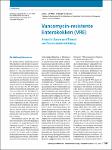Vancomycin-resistente Enterokokken (VRE)
Klare, Ingo
Witte, Wolfgang
Wendt, Constanze
Werner, Guido
Enterokokken (vorrangig E. faecalis, E. faecium) sind bedeutende nosokomiale Erreger, die vor allem bei älteren und/oder immunsupprimierten Patienten auftreten. Sie besitzen ein breites Spektrum an intrinsischen und erworbenen Antibiotikaresistenzen, von denen die übertragbaren Glycopeptidresistenzgenotypen vanA und vanB in Vancomycin-resistenten Enterokokken (VRE; Reservoir: E. faecium) sowie Resistenzen gegen Reserveantibiotika (Linezolid, Tigecyclin) von besonderem Interesse sind. Außerdem zeichnen sich Enterokokken (einschließlich VRE) durch ihre leichte Übertragbarkeit aus und können somit als Indikatorkeim für eine nosokomiale Ausbreitung angesehen werden, wobei Kolonisationen deutlich häufiger auftreten als Infektionen. Seit einigen Jahren liegen die Resistenzhäufigkeiten gegen Vancomycin bei klinischen E.-faecium-Isolaten bei 8–15% auf einem konstanten Niveau (aber mit lokalen und regionalen Schwankungen) und zeigen für Teicoplanin einen leicht rückläufigen Trend. Dies korreliert mit der Verbreitung Hospital-assoziierter vanA- und in den letzten Jahren vanB-positiver E.-faecium-Stämme (Letztere assoziiert mit Teicoplanin-Empfindlichkeit). Die Ursachen für das deutlich zunehmende Auftreten von VanB-E.-faecium-Stämmen sind offenbar multifaktoriell: durch therapeutische Faktoren verursacht (gestiegener Verbrauch an Enterokokken-/VRE-selektierenden Antibiotika in der Vergangenheit) und methodisch bedingt (EUCAST-gesenkte Glycopeptid-MHK-Grenzwerte für Enterokokken; häufigeres und verbessertes VRE-Screening; molekulare diagnostische Verfahren). Enterococci (mainly E. faecalis, E. faecium) are important nosocomial pathogens predominantly affecting older and/or immunocompromised patients. The bacteria possess a broad spectrum of intrinsic and acquired antibiotic resistance properties. Among these, the transferrable glycopeptide resistance of the vanA and vanB genotypes in vancomycin-resistant enterococci (VRE; reservoir: E. faecium) as well as resistance to last resort antibiotics (e.g. linezolid and tigecycline) are of special concern. Enterococci (including VRE) are easily transferred in hospitals; however, colonizations are far more frequent than infections. Resistance frequencies for vancomycin in clinical E. faecium isolates have remained at a relatively constant level of 8–15% (but with local or regional variations) in recent years whereas frequencies for teicoplanin resistance have shown a slight decrease. Glycopeptide resistance trends correlate with a spread of hospital-associated E. faecium strains carrying the vanA and, with rising frequency in recent years, the vanB gene cluster, the latter being associated with teicoplanin susceptibility. This increased occurrence of vanB-positive E. faecium strains may be caused by an increased use of antibiotics selecting enterococci and VRE as well as due to methodological reasons (e.g. reduced EUCAST MIC-breakpoints for glycopeptides; increased use and sensitive performance of chromogenic VRE agars, increased use of molecular diagnostic assays).
No license information

